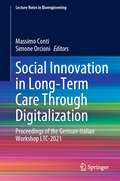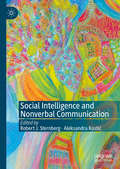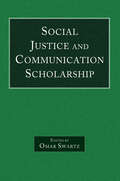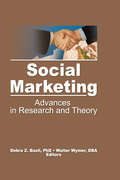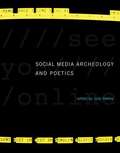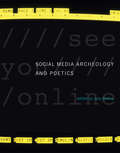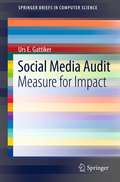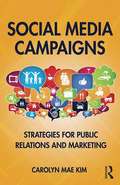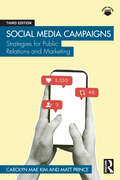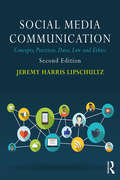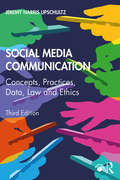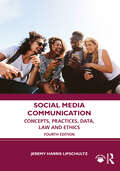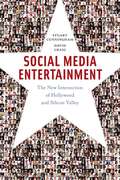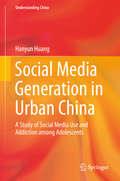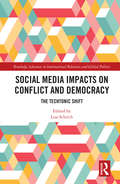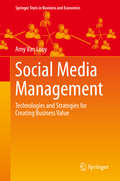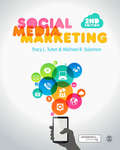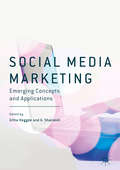- Table View
- List View
Social Influences on Romantic Relationships
by Christopher R. AgnewHow do we choose a partner to initiate a relationship with, and what makes us stay in a given relationship over time? These questions are most often pursued by scholars with an emphasis on the internal thoughts, feelings, and motivations of individual decision-makers. Conversely, this volume highlights the importance of considering external influences on individual decision-making in close relationships. Featuring contributions from internationally renowned scholars, the volume is divided into two interrelated sections. The first section considers global and societal influences on romantic relationships and the second focuses on social network and communicative influences on romantic relationships. Taken together, this collection helps us to better understand how external factors influence the internal machinations of those involved in intimate relationships.
Social Innovation in Long-Term Care Through Digitalization: Proceedings of the German-Italian Workshop LTC-2021 (Lecture Notes in Bioengineering)
by Simone Orcioni Massimo ContiThis book gathers extended contributions to the workshop on Long-Term Digital Care, LTC-2021, organized by the Università Politecnica delle Marche (UNIVPM), Ancona, Italy, and the Hochschule Konstanz (HTWG), Germany, in November 2021, and funded by the DAAD Joint Mobility Program. It covers innovative, practice-oriented approaches that are expected to foster digital health care, with a special focus on improving internationalization and accessibility. The book, which bridges between technological and social disciplines, reports on selected studies with the main goals of: establishing a comparison of Long-Term Digital Care approaches, with focus on exchange and networking processes; defining practical roadmaps for digital social innovation; establishing concepts and methods for process evaluation and sustainability. It offers a timely snapshot on technologies for patient monitoring and assistant systems, medical data analysis and image processing, digital platforms and advanced diagnostics techniques, and discusses important concepts relating to traceable process evaluation, networking and accessibility. It aims at informing, yet it is also intended to inspire and foster a stronger collaboration across disciplines, countries, as well as academic and professional institutions.
Social Intelligence and Nonverbal Communication
by Robert J. Sternberg Aleksandra KostićThis book offers a comprehensive overview of the latest developments in the social psychology of nonverbal communication. It explores topics including social skill, empathy, adaptive advantage, emotion-reading and emotion-hiding; and examines personal charisma, memory and communicating with robots. Together, the authors present diverse, cutting-edge research on nonverbal social intelligence as an adaptive strategy for survival and success. The collection provides an effective demonstration of the interdisciplinary nature of this topic, and it’s relevance to researchers across the social sciences and beyond.
Social Justice and Communication Scholarship (Routledge Communication Series)
by Omar SwartzSocial Justice and Communication Scholarship explores the role of communication in framing and contributing to issues of social justice. This collection, a first on the subject of communication and social justice, investigates the theoretical and practical ways in which communication scholarship can enable inclusive and equitable communities within American society. It analyzes ways in which to construct communities that protect individual freedom while ensuring equality and dignity to everyone. In this unique anthology, Swartz brings together both senior scholars and junior colleagues to represent diverse applications of communication to issues of social justice. He supports partisan scholarship in order to revitalize intellectual activity and social commitment toward creating a progressive society. As a result; the volume serves the heuristic function of posing new research questions. In addition to its relevance within the field of communication, Social Justice and Communication Scholarship will be of interest in many of the humanities and social sciences, as research on the theme of social justice transcends disciplinary boundaries. The volume is particularly well suited for use in undergraduate and graduate courses in communication, rhetoric and composition, journalism, American studies, and cultural studies.
Social Justice, Activism and Diversity in U.S. Media History
by Teri FinnemanThis book offers a diverse approach to journalism history told from a multimedia perspective, re-examining mainstream stories and highlighting contributions that are often overlooked. Bringing together a team of prominent journalism historians, the volume centers race and ethnicity, gender and sexuality, class, religion, disability, mental health and generations to tell forgotten stories of journalism’s historical influence. The book is designed to appeal to Generation Z college students, offering budding mass communicators a valuable tool that addresses gaps in historical pedagogy and fosters representation in the classroom. Each chapter contains access to video and podcast extras, chapter summaries, guides to further reading and suggested activities to bring these narratives alive and keep readers engaged. Interactive and accessible, Social Justice, Activism and Diversity in U.S. Media History is an indispensable resource for Generation Z, scholars in mass communication and American history, journalists and general readers.
Social Marketing: Advances in Research and Theory (Springer Texts In Business And Economics Ser.)
by Walter W. Wymer Jr Debra BasilLearn what marketing practices can positively impact behaviorThe success of the application of commercial marketing practices to change behavior for the betterment of society and the individual is getting more attention. Social Marketing: Advances in Research and Theory explores the use of social marketing through a variety of effective approaches. Chapters examine case studies and qualitative research to gain insight into the adoption of marketing practices to enable social change. This superb collection of top presentations from the SMART (Social Marketing Advances in Research and Theory) inaugural conference held in 2004 in Alberta, Canada provides examples of the latest commercial marketing practices to change behavior such as programs to encourage people to quit smoking or increase seat belt usage.Social Marketing: Advances in Research and Theory presents top experts who provide a wide variety of specific examples explaining ways to enable social marketing to positively impact behavior. This helpful resource provides a broad, useful understanding of this unique type of marketing and its goals. Chapters offer extensive references and detailed tables and figures to clearly present data.Topics in Social Marketing: Advances in Research and Theory include: a case study on approaches to anti-doping behavior in sports a case study reviewing the evolution of the Canadian Heritage anti-racism campaign applying social marketing concepts to increase capacity of programs in a state health department research into a recycling promotion technique using Internet technology to study the impact of anti-smoking messages issues involved in the voluntary change in behavior of automobile users charity support behaviorsSocial Marketing: Advances in Research and Theory is an insightful resource valuable to academics and practitioners interested in social marketing, or anyone working with nonprofits to change individual behavior and better society.
Social Media Archeology and Poetics
by Judy MalloyFocusing on early social media in the arts and humanities and on the core role of creative computer scientists, artists, and scholars in shaping the pre-Web social media landscape, Social Media Archeology and Poetics documents social media lineage, beginning in the 1970s with collaborative ARPANET research, Community Memory, PLATO, Minitel, and ARTEX and continuing into the 1980s and beyond with the Electronic Café, Art Com Electronic Network, Arts Wire, The THING, and many more.With first person accounts from pioneers in the field, as well as papers by artists, scholars, and curators, Social Media Archeology and Poetics documents how these platforms were vital components of early social networking and important in the development of new media and electronic literature. It describes platforms that allowed artists and musicians to share and publish their work, community networking diversity, and the creation of footholds for the arts and humanities online. Anditinvites comparisons of social media in the past and present, asking: What can we learn from early social media that will inspire us to envision a greater cultural presence on contemporary social media?ContributorsMadeline Gonzalez Allen, James Blustein, Hank Bull, Annick Bureaud, J. R. Carpenter, Paul E. Ceruzzi, Anna Couey, Amanda McDonald Crowley, Steve Dietz, Judith Donath, Steven Durland, Lee Felsenstein, Susanne Gerber, Ann-Barbara Graff, Dene Grigar, Stacy Horn, Antoinette LaFarge, Deena Larsen, Gary O. Larson, Alan Liu, Geert Lovink, Richard Lowenberg, Judy Malloy, Scott McPhee, Julianne Nyhan, Howard Rheingold, Randy Ross, Wolfgang Staehle, Fred Truck, Rob Wittig, David R. Woolley
Social Media Archeology and Poetics (Leonardo)
by Judy MalloyFirst person accounts by pioneers in the field, classic essays, and new scholarship document the collaborative and creative practices of early social media.Focusing on early social media in the arts and humanities and on the core role of creative computer scientists, artists, and scholars in shaping the pre-Web social media landscape, Social Media Archeology and Poetics documents social media lineage, beginning in the 1970s with collaborative ARPANET research, Community Memory, PLATO, Minitel, and ARTEX and continuing into the 1980s and beyond with the Electronic Café, Art Com Electronic Network, Arts Wire, The THING, and many more.With first person accounts from pioneers in the field, as well as papers by artists, scholars, and curators, Social Media Archeology and Poetics documents how these platforms were vital components of early social networking and important in the development of new media and electronic literature. It describes platforms that allowed artists and musicians to share and publish their work, community networking diversity, and the creation of footholds for the arts and humanities online. And it invites comparisons of social media in the past and present, asking: What can we learn from early social media that will inspire us to envision a greater cultural presence on contemporary social media?ContributorsMadeline Gonzalez Allen, James Blustein, Hank Bull, Annick Bureaud, J. R. Carpenter, Paul E. Ceruzzi, Anna Couey, Amanda McDonald Crowley, Steve Dietz, Judith Donath, Steven Durland, Lee Felsenstein, Susanne Gerber, Ann-Barbara Graff, Dene Grigar, Stacy Horn, Antoinette LaFarge, Deena Larsen, Gary O. Larson, Alan Liu, Geert Lovink, Richard Lowenberg, Judy Malloy, Scott McPhee, Julianne Nyhan, Howard Rheingold, Randy Ross, Wolfgang Staehle, Fred Truck, Rob Wittig, David R. Woolley
Social Media Audit
by Urs E. GattikerSocial media has drastically improved the way we can reach target audiences and serve our customers. Like its financial counterpart, the social media audit (SMA) can be described as a formalized review of anorganization's social media activities. However, contrary to financial audits, social media audits are not guided by government regulations or a set of professional rules and standards. This book will address social media marketing issues using a cost benefit approach, while presenting a systematic approach to review the organization's social media activities. Using the checklists and templates provided in this book will enable readers to conduct an audit that helps identify target areas for performance improvement and recommendations for how to achieve these objectives. Social media platforms discussed include: Facebook, LinkedIn, Google Plus, Twitter, Tumblr, and Xing.
Social Media Campaigns: Strategies for Public Relations and Marketing
by Carolyn Mae KimSocial media has ushered in a new era of communication between organizations and key stakeholders. This text guides readers through a four-step process of developing a robust social media campaign. Covering the latest industry standards and best practices to engage digital audiences through social listening, strategic design, creative engagement and evaluation, each chapter also includes expert insights from social media professionals. Focusing on principles rather than a specific platform, this is a text dedicated to developing social media competency that can adapt to any organization or environment.?
Social Media Campaigns: Strategies for Public Relations and Marketing
by Carolyn Mae KimThis new edition continues to give students a foundation in the principles of digital audience engagement and data metrics across platforms, preparing them to adapt to the quickly evolving world of digital media. It takes students through the processes of social listening, strategic design,creative engagement, and evaluation, with expert insights from social media professionals. Thoroughly updated, this second edition includes: • new strategies to guide students in the initial campaign planning phase • added content on influencers, social care teams, and newsjacking • coverage of research evaluation, the implications of findings, and articulating the ROI • expanded discussion of ethical considerations in campaign design and data collection and analysis. The book is suited to both undergraduate and post-graduate students as a primary text for courses in social/digital media marketing and public relations or a secondary text in broader public relations and marketing campaign planning and writing courses. Accompanying online resources include chapter reviews with suggestions for further resources; instructor guides; in-class exercises; a sample syllabus, assignments, and exams; and lecture slides. Visit www.routledge.com/9780367896201
Social Media Campaigns: Strategies for Public Relations and Marketing
by Carolyn Mae Kim Matthew PrinceThis third edition continues to give students a foundation in the principles of social media strategic communication and marketing necessary for today’s communications professionals.In many ways, organizations now have access to more data and connection points than ever before. Yet, this abundance requires more strategic and nuanced efforts. At its core, however, one aspect remains the same: The drive to create authentic human connection. Focusing on the principles for effective strategic communication via social media, this text allows readers to learn techniques and skills that transfer to different social media platforms. This edition again takes students through the processes of social listening, strategic design, creative engagement, and evaluation, with expert insights from social media professionals. This third edition includes: New insights on AI, ethics, and organizational strategy that reflect the changing landscape of social media. Expanded insights from industry professionals to equip students with diverse perspectives on leading social media hot topics. Updated case studies and real-world examples that showcase how successful brands are navigating the latest trends in earned media, influencer marketing, and community management. This is an ideal text for undergraduate and post-graduate courses in social/digital media marketing and public relations, or a secondary text in broader campaign planning and writing courses.Accompanying gratis online resources include chapter reviews, PowerPoint slides, sample syllabi, in-class exercises, and more.
Social Media Communication: Concepts, Practices, Data, Law and Ethics
by Jeremy Harris LipschultzIn Social Media Communication: Concepts, Practices, Data, Law and Ethics, Jeremy Harris Lipschultz presents a wide-scale, interdisciplinary analysis and guide to social media. Examining platforms such as Twitter, Facebook, LinkedIn, Pinterest, Youtube and Vine, the book explores and analyzes journalism, broadcasting, public relations, advertising and marketing. Lipschultz focuses on key concepts, best practices, data analyses, law and ethics--all promoting the critical thinking professionals and students need to use new networking tools effectively and to navigate social and mobile media spaces. Featuring contemporary case studies, essays from some of the industry's leading social media innovators, and a comprehensive glossary, this practical, multipurpose textbook gives readers the resources they'll need to both evaluate and utilize current and future forms of social media. For more information about the book, supplementary updates and teaching materials, follow Social Media Communication online at: Facebook: https://www.facebook.com/SocialMediaCommunication Twitter: @JeremyHL #smc2015 SlideShare: http://www.slideshare.net/jeremylipschultz
Social Media Communication: Concepts, Practices, Data, Law and Ethics
by Jeremy Harris LipschultzIn the second edition of Social Media Communication: Concepts, Practices, Data, Law and Ethics, Jeremy Harris Lipschultz presents a wide-scale, interdisciplinary analysis and guide to social media. Examining platforms such as Facebook, Instagram, Snapchat, LinkedIn, YouTube and Pinterest, this book explores and analyzes journalism, broadcasting, public relations, advertising and marketing. Lipschultz focuses on key concepts, best practices, data analyses, law and ethics—all promoting the critical thinking professionals and students need to use new networking tools effectively and to navigate social and mobile media spaces. Featuring historical markers and contemporary case studies, essays from some of the industry’s leading social media innovators and a comprehensive glossary, this practical, multipurpose textbook gives readers the resources they’ll need to both evaluate and utilize current and future forms of social media. For more information about the book, supplementary updates and teaching materials, follow the Social Media Communication Facebook page, @JeremyHL on Twitter and the UNO Social Media Lab on SlideShare. Facebook: www.facebook.com/SocialMediaCommunication Twitter: @JeremyHL #UNOSML #SMC2018 #SMProfs SlideShare: www.slideshare.net/jeremylipschultz
Social Media Communication: Concepts, Practices, Data, Law and Ethics
by Jeremy Harris LipschultzThis updated third edition presents a wide-scale, interdisciplinary guide to social media. Examining platforms like Facebook, Instagram, LinkedIn, Snapchat, TikTok, Twitter and YouTube, the book analyzes social media's use in journalism, broadcasting, public relations, advertising and marketing. Lipschultz focuses on key concepts, best practices, data analyses, law and ethics – all promoting the critical thinking that is needed to use new, evolving and maturing networking tools effectively within social and mobile media spaces. Featuring historical markers and contemporary case studies, essays from some of the industry’s leading social media innovators and a comprehensive glossary, this practical, multipurpose textbook gives readers the resources they will need to both evaluate and utilize current and future forms of social media communication. Among other changes, updates to the third edition include a deep dive into new approaches to analytics, as well as greater discussion of law and ethics in light of the Facebook Cambridge Analytica scandal, the roll-out of GDPR and new case law relating to social media. Social Media Communication is the perfect social media primer for students and professionals, and, with a dedicated teaching guide, ideal for instructors, too.
Social Media Communication: Concepts, Practices, Data, Law and Ethics
by Jeremy Harris LipschultzThis updated fourth edition presents a wide-scale, interdisciplinary guide to social media communication. Examining platforms like Facebook, Instagram, Snapchat, TikTok, Twitter and YouTube, the book analyzes social media's use in journalism, public relations, advertising and marketing. Lipschultz focuses on key concepts, best practices, data analyses, law and ethics – all promoting the critical thinking that is needed to use new, evolving and maturing networking tools effectively within social and mobile media spaces. Featuring historical markers and contemporary case studies, essays from some of the industry’s leading social media innovators and a comprehensive glossary, this practical, multipurpose textbook gives readers the resources they will need to both evaluate and utilize current and future forms of social media communication. Updates to the fourth edition include expanded discussion of disinformation, the impact of artificial intelligence (AI), natural language chatbots, virtual and augmented reality technologies and the COVID-19 infodemic. Social Media Communication is the perfect social media primer for students and professionals and, with a dedicated online teaching guide, ideal for instructors, too.
Social Media Communication: Trends and Theories
by Bu ZhongExamines the social media mechanism and how it is transforming communication in an increasingly networked society Social Media Communication: Trends and Theories explores how social media is transforming the way people think and behave. Providing students with an in-depth understanding of the mechanism underlying social media, this comprehensive textbook uses a multidisciplinary approach to examine social media use in a wide range of communication and business contexts. Each chapter is based on original research findings from the author as well as recent work in communication studies, neuroscience, information science, and psychology. Divided into two parts, the text first describes the theoretical foundation of social media use, discussing the impact of social media on information processing, social networking, cognition, interpersonal and group communication, the media industry, and business marketing. The second half of the book focuses on research-based strategies for effectively using social media in communication and business such as the news industry, heath care, and social movements. Offering detailed yet accessible coverage of how digital media technology is changing human communication, this textbook: Helps readers make the best use of social media tools in communication and business practices Introduces more than a dozen theories in the areas of communication, psychology, and sociology to highlight the theoretical frameworks researchers use in social media studies Identifies a variety of trends involving social media usage, including the app economy and patient care Addresses the relation between social media and important contemporary topics such as cultural diversity, privacy, and social change Presents 14 imperative social media topics, each with the power to change the ways you see and use social media Social Media Communication: Trends and Theories is the perfect textbook for undergraduate and graduate courses in communication, business, journalism, business, and information science and technology. It is also an invaluable resource for researchers, educators, journalists, entrepreneurs, and professionals working in media management, advertising, public relations, and business marketing.
Social Media Entertainment: The New Intersection of Hollywood and Silicon Valley (Postmillennial Pop #7)
by Stuart Cunningham David CraigWinner, 2020 Outstanding Book Award, given by the International Communication AssociationHonorable Mention, 2020 Nancy Baym Book Award, given by the Association of Internet ResearchersHow the transformation of social media platforms and user-experience have redefined the entertainment industryIn a little over a decade, competing social media platforms, including YouTube, Facebook, Twitter, Instagram, and Snapchat, have given rise to a new creative industry: social media entertainment. Operating at the intersection of the entertainment and interactivity, communication and content industries, social media entertainment creators have harnessed these platforms to generate new kinds of content separate from the century-long model of intellectual property control in the traditional entertainment industry. Social media entertainment has expanded rapidly and the traditional entertainment industry has been forced to cede significant power and influence to content creators, their fans, and subscribers. Digital platforms have created a natural market for embedded advertising, changing the worlds of marketing and communication in their wake. Combined, these factors have produced new, radically shifting demands on the entertainment industry, posing new challenges for screen regimes, media scholars, industry professionals, content creators, and audiences alike.Stuart Cunningham and David Craig chronicle the rise of social media entertainment and its impact on media consumption and production. A massive, industry-defining study with insight from over 100 industry insiders, Social Media Entertainment explores the latest transformations in the entertainment industry in this time of digital disruption.
Social Media Generation in Urban China
by Hanyun HuangSocial media such as instant messaging (IM), social networking sites (SNS), blogs and microblogs are an integral part of adolescents' lives in China. Anecdotal evidence reported in the news has suggested that the increasing popularity of social media could make adolescents more vulnerable to being addicted. This exploratory study proposes the concept of "social media addiction" and examines (a) whether social media addiction exists among adolescents in urban China and, if so, who the addicts are, what their symptoms are and to what extent they are addicted; (b) whether sociopsychological traits (e. g. , need for affiliation, impression management, narcissism and leisure boredom) can predict social media addiction among adolescents; (c) what gratifications are obtained by adolescents from their use of social media and whether these gratifications can predict social media addiction and (d) to what degree social media addiction influences adolescents' academic performance and social capital. This study employed quantitative questionnaire surveys among adolescents as the main research method, supplemented by qualitative pre-survey focus groups among adolescents and post-survey in-depth interviews among parents and teachers. Questionnaire surveys were conducted based on a multi-stage cluster sampling of seven middle schools in five urban Chinese cities: Beijing, Shanghai, Guangzhou, Shenzhen and Xiamen. The final sample consisted of 1,549 adolescents, of whom 90% had used social media. Using Young's classic definition of Internet addiction, 15. 6% of participants were classified as social media addicts. The addicted adolescents were often self-absorbed, bored with their leisure time, and good at using manipulation through social media for impression management. Addicts experienced four major social media addiction symptoms: preoccupation, adverse consequences, alleviation of negative emotions and loss of interest in social activities. The seven social media gratifications identified in this study can be categorized into social, information and entertainment gratifications. Among these, entertainment gratifications had the most power to predict social media addiction, while information gratifications were the least likely to lead to addiction. Furthermore, these gratifications were found to be powerful mediators between the adolescents' sociopsychological traits and social media addiction. Finally, the results also indicated that social media addiction and its symptoms had a significant negative impact on adolescents' academic performance and social capital.
Social Media Impacts on Conflict and Democracy: The Techtonic Shift (Routledge Advances in International Relations and Global Politics)
by Lisa SchirchSocial media technology is having a dramatic impact on social and political dynamics around the world. The contributors to this book document and illustrate this "techtonic" shift on violent conflict and democratic processes. They present vivid examples and case studies from countries in Africa, South and Southeast Asia, Latin America as well as Northern Ireland. Each author maps an array of peacebuilding solutions to social media threats, including coordinated action by civil society, governments and tech companies to protect human minds, relationships and institutions. Solutions presented include inoculating society with a new digital literacy agenda, designing technology for positive social impacts, and regulating technology to prohibit the worst behaviours. A must-read both for political scientists and policymakers trying to understand the impact of social media, and media studies scholars looking for a global perspective.
Social Media Intelligence
by Wendy W. Moe David A. SchweidelIn the world of Facebook, Twitter and Yelp, water-cooler conversations with co-workers and backyard small talk with neighbors have moved from the physical world to the digital arena. In this new landscape, organizations ranging from Fortune 500 companies to government agencies to political campaigns continuously monitor online opinions in an effort to guide their actions. Are consumers satisfied with our product? How are our policies perceived? Do voters agree with our platform? Measuring online opinion is more complex than just reading a few posted reviews. Social media is replete with noise and chatter that can contaminate monitoring efforts. By knowing what shapes online opinions, organizations can better uncover the valuable insights hidden in the social media chatter and better inform strategy. This book can help anyone facing the challenge of making sense of social media data to move beyond the current practice of social media monitoring to more comprehensive use of social media intelligence.
Social Media Management
by Amy Van LooyThis undergraduate textbook adopts the perspective of organizations - not individuals - and clarifies the impact of social media on their different departments or disciplines, while also exploring how organizations use social media to create business value. To do so, the book pursues a uniquely multi-disciplinary approach, embracing IT, marketing, HR and many other fields. Readers will benefit from a comprehensive selection of current topics, including: tools, tactics and strategies for social media, internal and external communication, viral marketing campaigns, social CRM, employer branding, e-recruiting, search engine optimization, social mining, sentiment analysis, crowdfunding, and legal and ethical issues.
Social Media Marketing
by Dr Tracy L. Tuten Professor Michael R. SolomonSocial Media Marketing was the first textbook to cover this vital subject. It shows how social media fits into and complements the marketer's toolbox. The book melds essential theory with practical application as it covers core skills such as strategic planning for social media applications, incorporating these platforms into the brand's marketing communications executions, and harnessing social media data to yield customer insights. The authors outline the 'Four Zones' of social media that marketers can use to achieve their strategic objectives. These include: 1. Community (e.g. Instagram) 2. Publishing (e.g. Tumblr) 3. Entertainment (e.g. Candy Crush Saga) 4. Commerce (e.g. Groupon) This second edition contains new examples, industry developments and academic research to help students remain current in their marketing studies, as well as a new and improved user-friendly layout to make the text easy to navigate. The textbook also provides a free companion website that offers valuable additional resources for both instructors and students. Visit: study.sagepub.com/smm. Readers of the book are also invited to join the authors and others online by using the hashtag: #smm
Social Media Marketing
by Githa Heggde G. ShaineshThis book focuses on the role of social media as the next major game-changer. Social media has emerged as the defining trend in the last decade and continues to restructure communication and interactions between individuals, communities, governments and businesses. Researchers and marketers are still struggling with the profound impact of rapidly evolving social media on viral user-generated content, its ability to shape consumer perceptions, and the constantly changing landscape for developing business cases to proactively engage with stakeholders. The growing opportunities to “hear” about customer priorities and concerns on company managed channels as well as third-party review sites, including social media pages, across the digital space are accompanied by the challenges of responding to these conversations in real-time, which calls for a massive shift in the way marketing functions engage in dialogue with customers. As leading users of social media in emerging markets, Indians are increasingly logging into their Facebook and Twitter accounts, with the country recording the highest growth in social networking. This book begins by discussing the impact of social media on marketing, from brand building, communications, and advertising to customization and customer engagement. The book approaches the subject matter systematically, identifying broad trends, concepts and frameworks in the first few chapters. It then goes on to address the varied application of social media in marketing for different sectors. Primarily focusing on understanding digital consumers, the book integrates social media with marketing and the outcome. It also presents new, selected cases of successful digital companies in emerging markets never before considered. Researchers and managers alike will find this book to be a handy reference guide to social media in emerging markets.
Social Media Marketing All-in-One For Dummies
by Michelle KrasniakShare your brand message and connect with your customers There's no way around it—social media is everywhere, and the savviest businesses are making the most of it. With the help of Social Media Marketing All-in-One For Dummies, you, too, can join the digital era and take your social media accounts to the next level. Accessible and comprehensive, this guide teaches you to apply your marketing skills to the latest social media platforms, allowing you to promote your business, reach customers, and thrive in the global marketplace. Get up to date with information on AI tools and AI-generated content, as well as voice search, short-form video content, and more. Let this Dummies book coach you to social media marketing success. Get acquainted with the top social media platforms for business marketing Learn how to create more compelling content—with or without the help of AI Consider social commerce and influencer partnerships in your marketing mix Use groups, communities, and private spaces to build trust and camaraderie This nine-in-one guide is perfect for social media strategists, web site managers, marketers, publicists, and anyone else in charge of an organization's social media strategy. It's also a great choice for entrepreneurs interested in learning how social media can help generate business.

